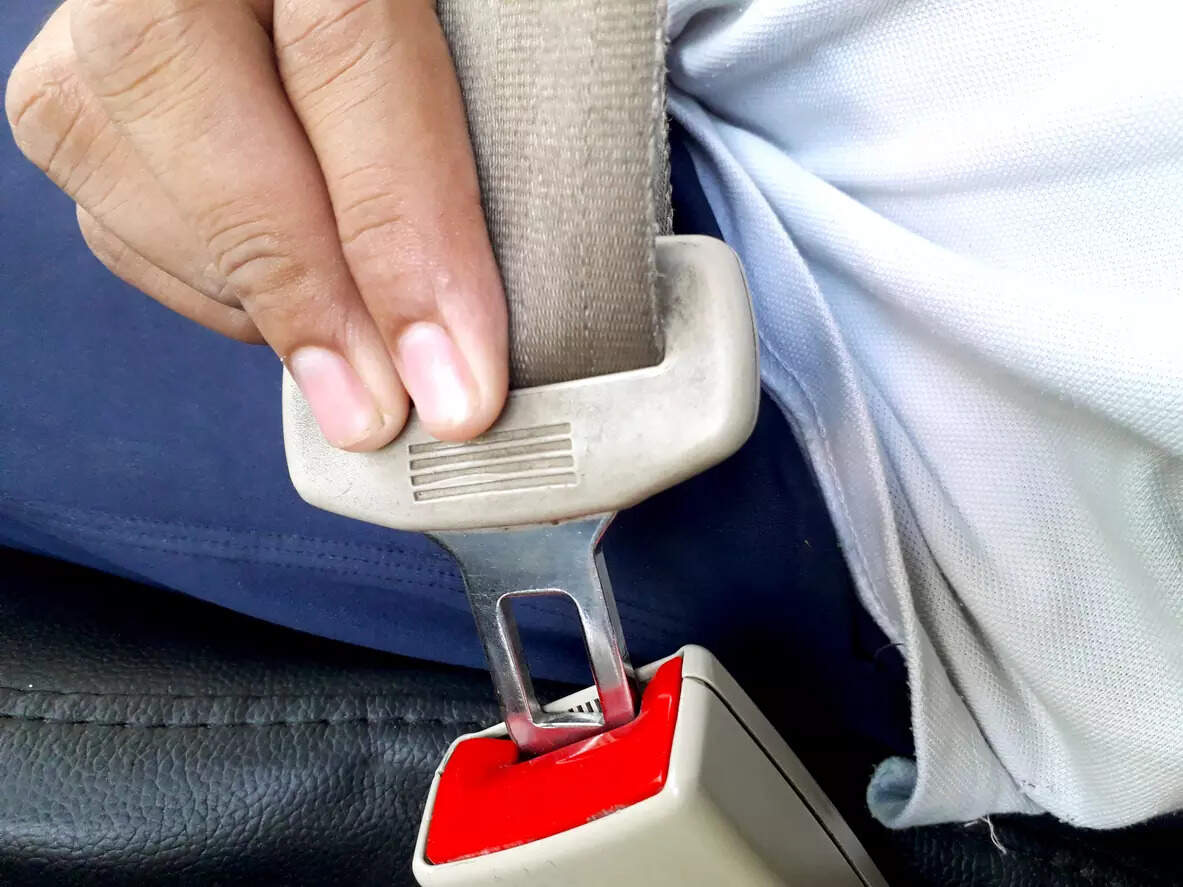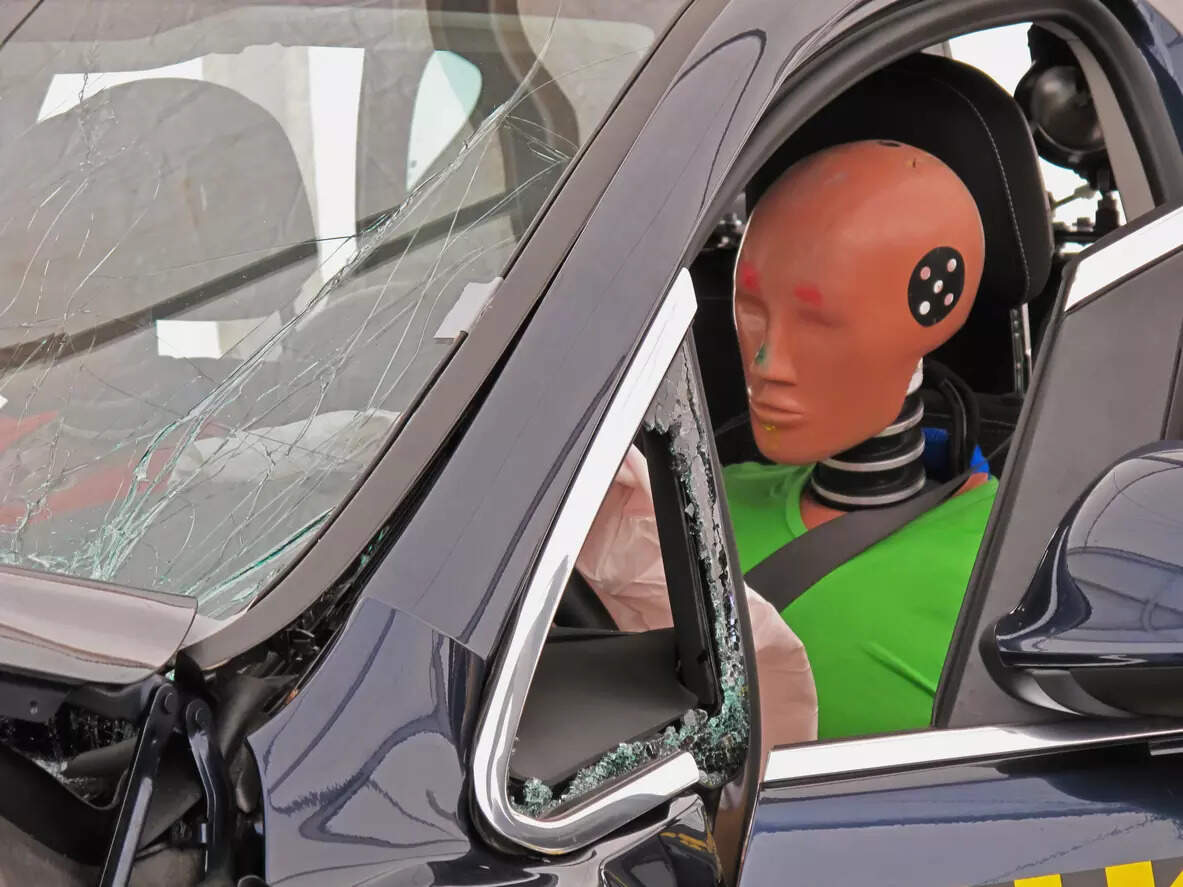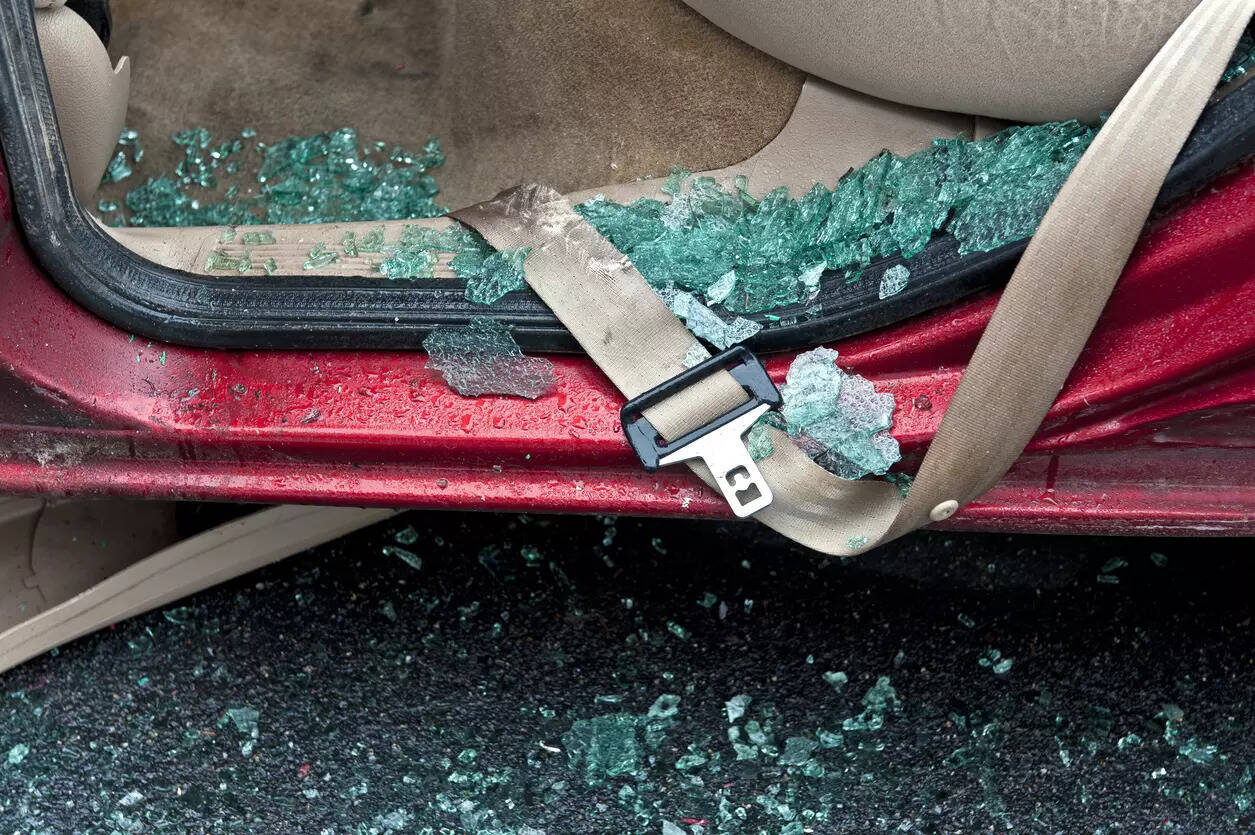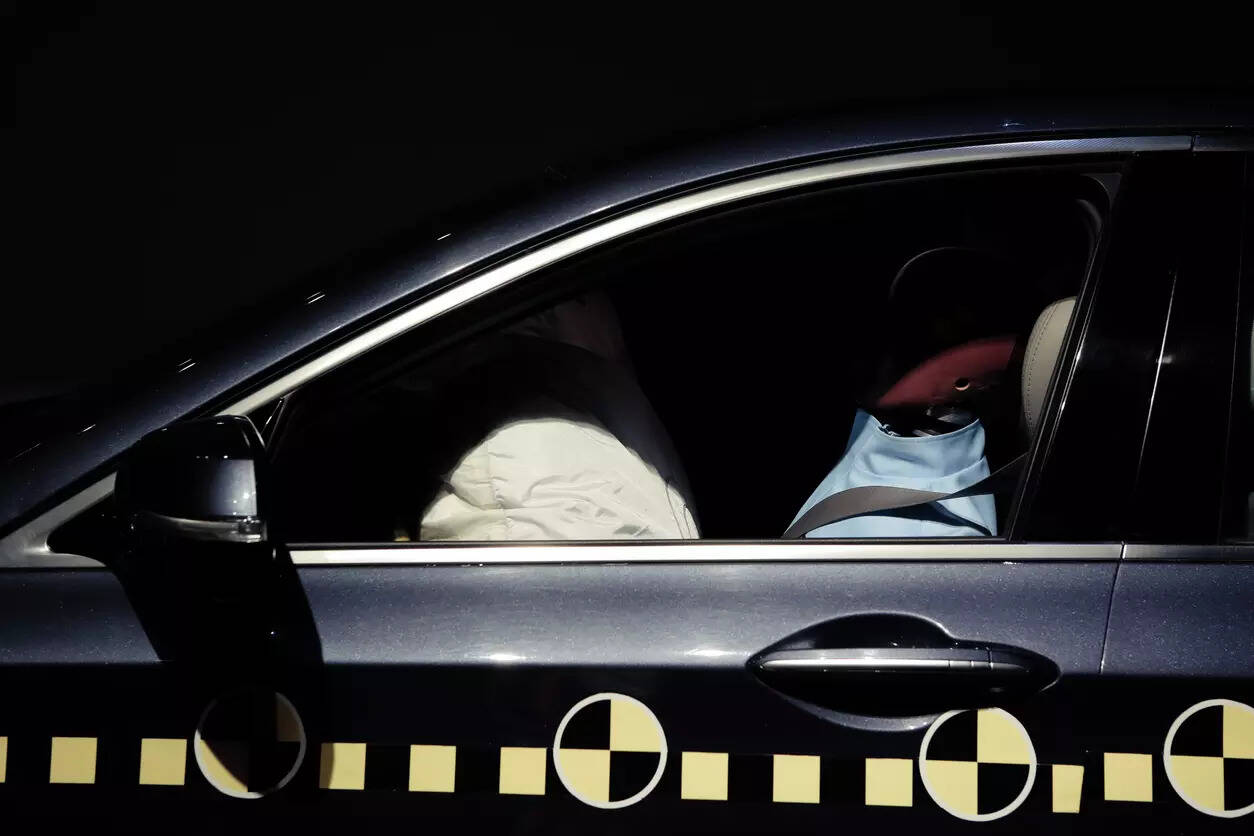 The RASSI crash sampled study on standard 3-point seat belt drivers highlights that massive passenger compartment intrusions (PCIs) in belted drivers lead to serious head injuries.
The RASSI crash sampled study on standard 3-point seat belt drivers highlights that massive passenger compartment intrusions (PCIs) in belted drivers lead to serious head injuries.“>
Seat belts are like red signals to many Indian drivers which are meant to be ignored. This trait is common in hilly states where it is common to hear drivers say, “Seat belts are dangerous. What if the car topples and we get trapped?”This fear, deeply rooted among drivers and passengers alike, continues to keep compliance rates alarmingly low despite overwhelming evidence that seat belts are among the most effective safety systems ever designed. From steering wheel impacts to ejections through windows, they are the simplest and most reliable way to prevent catastrophic injuries. Yet, doubts persist, especially in India’s mountainous regions. ETAuto spoke with drivers, road safety experts and researchers to understand why.
Seat belts limit reaction time
“Driving in the hilly regions is not like (driving) on the plains. Every minute, the situation changes and seat belts feel uncomfortable and limit our reaction time,” says a private car driver from Himachal Pradesh. Asked what makes him uncomfortable, he explains, “On turns, I want to keep a watch on the hill above…what if there is a rock rolling down? Some bends are too sharp and I need flexibility which is compromised when I wear a seat belt.”At the 15th Annual RASSI (Road Accident Sampling System India) Consortium Meeting in Dehradun, Uttarakhand, held earlier this year, local authorities raised similar concerns about taxi drivers operating in challenging hilly terrains who refuse to buckle up. Officials discussed with OEMs the possibility of exploring design solutions that could make seat belts more adaptable, comfortable and region-specific for diverse terrains.

“We understand that seat belts are important and ensure safety while driving but just look at the accidents in the hills,” says a taxi driver in Dehradun. In the Tehri accident of 2024, he adds, the person wearing a seat belt died even though the door opened, while the one not wearing it was thrown out of the vehicle and survived. “In the hills, we usually drive at just 20–50 kmph. The real issues are poor road infrastructure, lack of signages and unpredictable mountain conditions. Plus, there is a struggle to unbuckle at that golden hour to escape a landslide or a fall into the valley,” says the driver.
The myth of the trap
Sarika Panda Bhatt, Founder Trustee, Raahgiri Foundation, believes that seat belt use and attitudes, especially in hilly and mountainous areas, bring up important issues that are often overlooked.“Research in India’s hilly states shows that very few people wear seat belts, and those who don’t are more likely to be badly injured or thrown out of the vehicle,” she says. According to her, seat belts actually stop people from being ejected which is one of the main causes of death in rollovers. The idea that belts trap people is “mostly fear” and not a fact. Bhatt adds that design discomfort, cultural resistance, weak enforcement and lack of awareness are key barriers. “Closing this ‘trust gap’ will need stronger enforcement, better design and technology and awareness programmes,” she says.
No evidence in hilly terrain
“There is no scientific evidence proving that seat belt use increases the risk of accidents in hilly terrain,” concurs Rahul Mahajan, Senior Deputy Director and HoD Passive Safety Lab and Engineering, Design and Simulation, ARAI.
To increase the probability of protecting occupants in landslides, vehicle rollover etc. design countermeasures are offered on vehicle design. These include roll-bars and curtain airbags in passenger cars and strong superstructure for passenger buses, he adds.

Mahajan points to extensive NHTSA (National Highway Traffic Safety Administration) and EU Research that have found their way in regulatory requirements such as FMVSS 216 roof crush requirements on passenger cars, FMVSS 220 roof strength requirements on school buses, ECE R66 strength of superstructure on passenger buses and its equivalent in Indian standard, AIS031. “A systematic education programme needs to be undertaken for removing misconceptions regarding wearing of safety belts in hilly terrain. Further, there is a need for safety rescue infrastructure (eg. 911 and e-call etc.) which can support the occupants of the vehicle for rescue in a deformed structure condition,” he elaborates.
Since advance safety features and understanding them as per Indian road scenarios are at a nascent stage in India, any in-depth study/research on crash-forensics, biomechanics and pre-hospital data in hilly-terrain is still underway and “not yet available in the public domain.”
Bridging the trust gap with design
“Survival in a crash depends on both the car’s design and whether seat belts are used. Features like stronger roofs, reinforced cabins, roll-bars, side airbags, and clear escape plans (like exit tools or marked exits) all improve safety. However, the most important protection is still making sure people are strapped in when the crash happens,” explains Bhatt.
Simple tools like window breakers or easy-release buckles and basic driver training on what to do after a crash can reduce the fear of being trapped. “Seat belts with pre-tensioners, load limiters, adjustable straps, and quick-release mechanisms are already making rides safer and more comfortable,” she adds.
New ideas like smarter reminders that adapt to driving conditions such as “giving stronger alerts” on hilly roads can help more people actually wear them. Beyond the regular 3-point seat belt, new ideas are being tested.
“These include belts that tighten or loosen depending on the crash, systems that sense terrain or speed and prepare for rollovers, seat belts that adjust for comfort, quick-release buckles and cutters for emergencies, and stronger roofs with airbags and roll-over protection,” explains Bhatt.
The RASSI crash sampled study on standard 3-point seat belt drivers highlights that massive passenger compartment intrusions (PCIs) in belted drivers lead to serious head injuries. Increased RUPD (rear underrun protection device) fitment rate and improved design will help reduce PCI and the injury severity of the belted drivers in underride crashes.
RASSI’s analysis also highlighted that many of the crashes studied could have been prevented with Advanced Driver Assistance Systems (ADAS) features on the vehicles.

These findings reinforce that while seat belts are indispensable, vehicle design and intelligent safety systems must evolve together to protect occupants more effectively, particularly in high-risk terrains and mixed traffic conditions like India’s hilly regions.
“Adaptive pre-tensioners, adjustable anchors etc. are typically designed to consider variable occupant sizes (such as male, female etc.) and not for hilly-region driving scenarios. Quick release systems are integral to the design of seat belt design,” adds Mahajan.
Seat belts are equipped with spring-loaded buckles which help release the belt with forces manageable by humans. FMVSS requirements specify maximum buckle release forces of 1333N, whereas UNECE and AIS standards specify “maximum buckle release forces up to 100N, i.e. 10 kg”.
While reiterating that adequate roof strength meeting minimum regulatory requirements is always recommended, he says a strong superstructure means reduced risk of severe body deformation and enhanced possibility of occupant protection. FMVSS 216 specifies roof strength requirements for passenger vehicles. Currently in India, there is no equivalent requirement.
Additional safety enhancement mechanisms such as Bharat-NCAP can consider these requirements in future. He adds that integrated roll-protection systems are adopted by some countries as well as regional new car assessment programmes can be reviewed for adoption in India.
The numbers tell the story
According to Ministry of Road Transport and Highways (MoRTH), 16,025 persons were killed and 40,597 persons injured in road accidents caused by not wearing seat belts during 2023.
Persons killed and injured due to non-use of safety devices (seat belts) during 2023
| Category | Non wearing of Seat Belt | |
| Killed | Injured | |
| Drivers | 8,441 | 17,204 |
| % Share in Total | 52.7 | 42.4 |
| Passenger | 7,584 | 23,393 |
| % Share in Total | 47.3 | 57.6 |
| Total | 16,025 | 40,597 |
Source: Road Accidents in India 2023, Ministry of Road Transport and Highways (Transport Research Wing).
Uttar Pradesh ranked 1 in driver and passenger deaths in accidents due to non-wearing of seat belt in 2023 followed by Madhya Pradesh at 2. Uttarakhand and Himachal Pradesh stood at 20 and 21 respectively.
Evolution of the seat belt
Seat belt design has continuously evolved since its introduction. The inertia reel (belt retractor) appeared in the 1960s, followed by pretensioners and buckle pretensioners in the 1980s. A major advancement came in 1995 with the shoulder-belt force limiter, reducing chest injuries during high-impact crashes.
In 2002, Mercedes-Benz’s PRE-SAFE system marked a leap into active and integrated safety with its belt pre-pretensioner. Future improvements will likely focus on preventing upper-torso slippage during rollovers, protecting elderly occupants and reducing neck injuries caused by violent head motions.
Despite these innovations, the three-point seat belt remains the cornerstone of occupant protection. Its proven capability, when paired with modern restraint systems, continues to save lives whether on the plains or in the hills, as per the paper. The Evolution of the Three-point Seat Belt From Yesterday to Tomorrow by Yngve Håland and Autoliv Research (Vehicle Safety Department of Applied Mechanics Chalmers University of Technology).
Join the community of 2M+ industry professionals.
Subscribe to Newsletter to get latest insights & analysis in your inbox.
All about ETAuto industry right on your smartphone!
- Download the ETAuto App and get the Realtime updates and Save your favourite articles.





